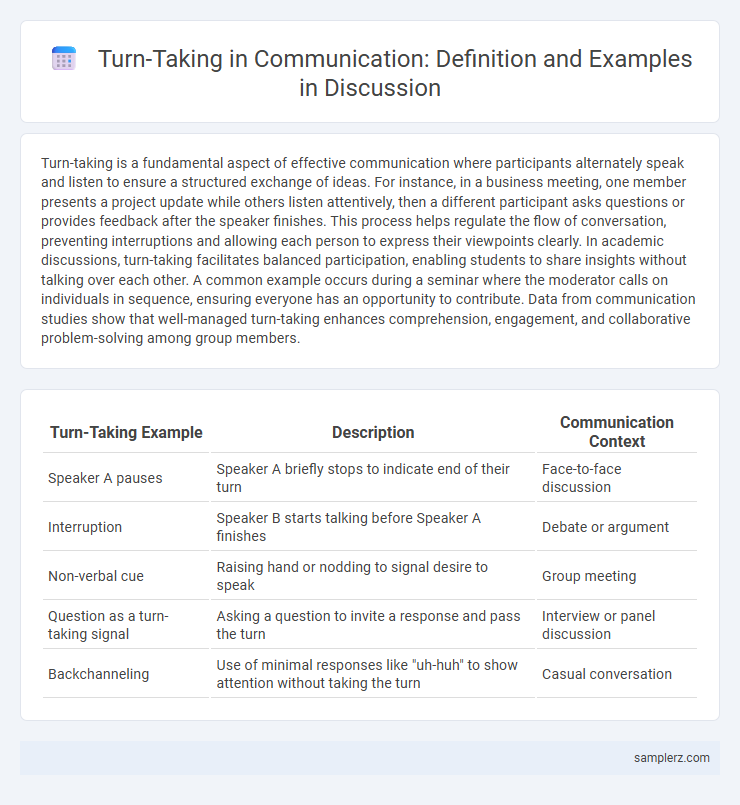Turn-taking is a fundamental aspect of effective communication where participants alternately speak and listen to ensure a structured exchange of ideas. For instance, in a business meeting, one member presents a project update while others listen attentively, then a different participant asks questions or provides feedback after the speaker finishes. This process helps regulate the flow of conversation, preventing interruptions and allowing each person to express their viewpoints clearly. In academic discussions, turn-taking facilitates balanced participation, enabling students to share insights without talking over each other. A common example occurs during a seminar where the moderator calls on individuals in sequence, ensuring everyone has an opportunity to contribute. Data from communication studies show that well-managed turn-taking enhances comprehension, engagement, and collaborative problem-solving among group members.
Table of Comparison
| Turn-Taking Example | Description | Communication Context |
|---|---|---|
| Speaker A pauses | Speaker A briefly stops to indicate end of their turn | Face-to-face discussion |
| Interruption | Speaker B starts talking before Speaker A finishes | Debate or argument |
| Non-verbal cue | Raising hand or nodding to signal desire to speak | Group meeting |
| Question as a turn-taking signal | Asking a question to invite a response and pass the turn | Interview or panel discussion |
| Backchanneling | Use of minimal responses like "uh-huh" to show attention without taking the turn | Casual conversation |
Understanding Turn-Taking in Discussions
Turn-taking in discussions involves participants alternating their speech to ensure balanced communication and avoid interruptions. Effective turn-taking requires recognizing verbal cues, such as pauses or intonation changes, and non-verbal signals like eye contact or hand gestures. Mastering this skill enhances clarity, mutual respect, and active listening within conversations.
Common Turn-Taking Signals in Conversation
Common turn-taking signals in conversation include vocal cues such as intonation changes, pitch variations, and pauses that signal a speaker's intention to yield or maintain their turn. Non-verbal signals like eye contact, hand gestures, and body orientation also play a crucial role in facilitating smooth transitions between speakers. These cues help prevent interruptions and ensure cooperative dialogue by indicating when it is appropriate for another participant to contribute.
Effective Verbal Cues for Turn-Taking
Effective verbal cues for turn-taking in discussions include phrases like "What do you think?" or "I'd like to add something," which signal a speaker's intent to yield or claim the floor. These cues help manage conversational flow by clearly indicating when it is appropriate for another participant to contribute. Utilizing explicit markers such as questions, pauses, or acknowledgments enhances collaborative dialogue and minimizes interruptions.
Nonverbal Turn-Taking Indicators
Nonverbal turn-taking indicators in discussions include gestures such as raised hands, eye contact shifts, and subtle head nods, which signal readiness to speak or yield the floor. These cues help manage conversational flow without interrupting verbal communication. Effective use of nonverbal signals enhances mutual understanding and reduces instances of overlapping speech.
Turn-Taking Example: Group Brainstorming
During a group brainstorming session, turn-taking enables each participant to contribute ideas sequentially, ensuring balanced involvement and preventing interruptions. Speakers often use verbal cues such as pausing or hand gestures to signal the end of their turn, allowing smooth transitions between contributors. Effective turn-taking enhances collaborative creativity by promoting equal participation and minimizing conversational overlap.
Turn-Taking in Classroom Discussions
Turn-taking in classroom discussions ensures each student has an opportunity to contribute, promoting active engagement and a balanced exchange of ideas. Teachers often use techniques such as signaling, raised hands, or assigned speaking order to manage participation and maintain order. Effective turn-taking enhances collaborative learning and helps develop students' communication and listening skills.
Managing Interruptions During Turn-Taking
Effective management of interruptions during turn-taking is crucial in maintaining coherent communication and respecting speaker roles. Techniques such as using hand signals, establishing ground rules, or employing a moderator help ensure smooth transitions and minimize overlapping speech. These strategies enhance clarity and engagement by allowing each participant to contribute without undue disruption.
Digital Communication and Turn-Taking Practices
Digital communication platforms utilize algorithms to manage turn-taking by signaling users when it is their opportunity to contribute, reducing interruptions and overlap. Features like "raise hand" buttons and automated queues help maintain conversational order during video conferences and chat rooms. These turn-taking practices enhance clarity and inclusivity, ensuring equitable participation in virtual discussions.
Cultural Differences in Turn-Taking
In Japanese communication, silence during turn-taking is valued as a sign of respect and reflection, contrasting with the rapid exchanges typical in American conversations. In Middle Eastern cultures, overlapping speech is common and signals engagement rather than interruption, differing from Western norms that emphasize waiting for a clear pause. Understanding these cultural differences in turn-taking enhances cross-cultural communication and reduces misunderstandings in diverse discussions.
Enhancing Turn-Taking Skills for Productive Dialogue
Effective turn-taking in discussions involves recognizing verbal and non-verbal cues to signal when it's appropriate to speak, fostering a balanced exchange of ideas. Techniques such as active listening and asking open-ended questions encourage participants to contribute meaningfully without interruption. Mastering these skills enhances collaborative problem-solving and ensures productive, respectful communication.

example of turn-taking in discussion Infographic
 samplerz.com
samplerz.com